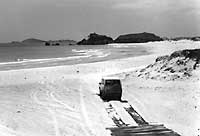|
|
||||
|
Work to overcome
cultural differences in the name of |
||||
|
Nhulunbury scenery near the
|
Natives of one of the remotest areas of the fifth continent were not consulted in ‘68 when a mine was opened on their territory, today however, all deforestation programmes and non-indigenous visiting rights are under their control In the Northern Territory, in North East Arnhem Land in one of Australia’s most remote regions, centuries old Aboriginal land management practices are being combined with modern European conservation methods. The project, managed by an organisation called Dhimurru, is working at bringing together both Aboriginal and European thinking on land management. Dhimurru believes that both ancient Aboriginal wisdom and modern scientific methods can be used for mutual benefit. Situated in the small township of Nhulunbuy along with its companion Aboriginal settlement of Yirrakala, Dhimurru employs both indigenous and non-indigenous staff and has, since its inception in 1992, developed a series of strategies aimed at coming to grips with the continuous cultural differences between indigenous and non indigenous people encountered since a bauxite mine was constructed there in 1968. This new philosophy of working together is a far cry from the bad old days, when the Yolngu People, the indigenous people of North East Arnhem Land were not consulted when the mine was first built on their ancestral lands. For the Yolngu People the coming of Nabalco (the North Australian Bauxite and Aluminium Company), has meant huge change. Apart from the odd missionary, anthropologist and Air Force personnel in the 1930s and 40s the Yolngu had never been exposed to a western way of life. Isolated from European settlement and remote from civilisation, it’s not surprising that the mine and the town built to accommodate 4000 people caused tensions within the community. The Yolngu reacted to this «invasion» by charging the Commonwealth Government of Australia and Nabalco with, «wrongfully entering their land». Anthropological and archaeological evidence showed that Yolngu clans had been active in this region for over 40 thousand years. But it wasn’t until 1976 that the Aboriginal Land Rights Act (N.T.) eventually passed into Australian law. This gave Aboriginal people the legal right to negotiate future activities on large tracts of land in Arnhem Land. Today, non-indigenous people wishing to visit Arnhem Land must apply for permits before entering Aboriginal Land. The forming of Dhimurru in 1992 has done much towards easing the tensions on both sides and recently a Yolngu spokesperson said that the Yolngu culture in the region was still strong. Today the policy of Nabalco includes a vigorous re-vegetation program carried out under the watchful eye of Aboriginal Elders. Yolngu people have also benefited from the introduction of a hospital, school and a system of modern communications and non-indigenous people are having the opportunity to understand traditional ways of hunting and fishing in what has been called «the world’s oldest marine management structure». Ngareta Rossell |
|||
|
|
||||


